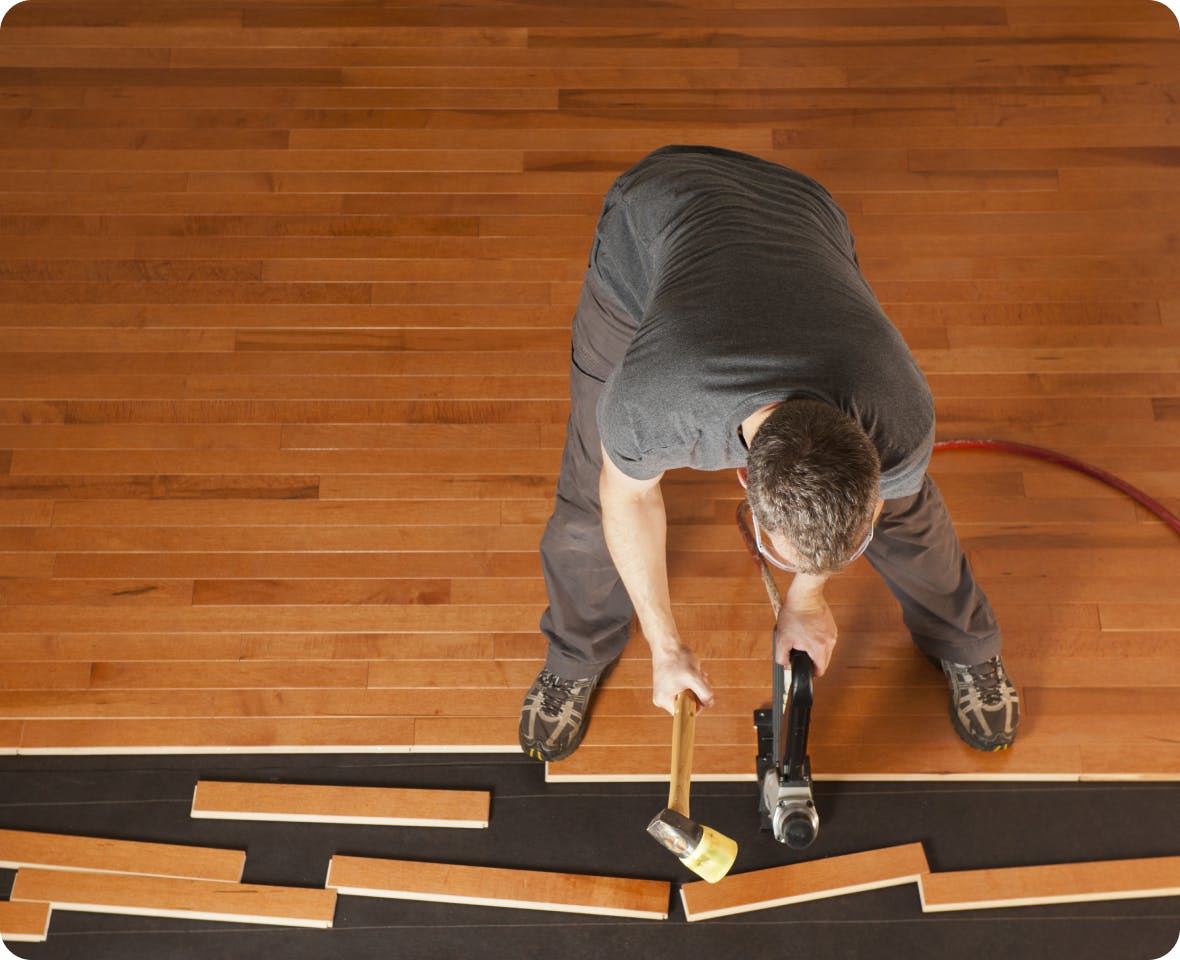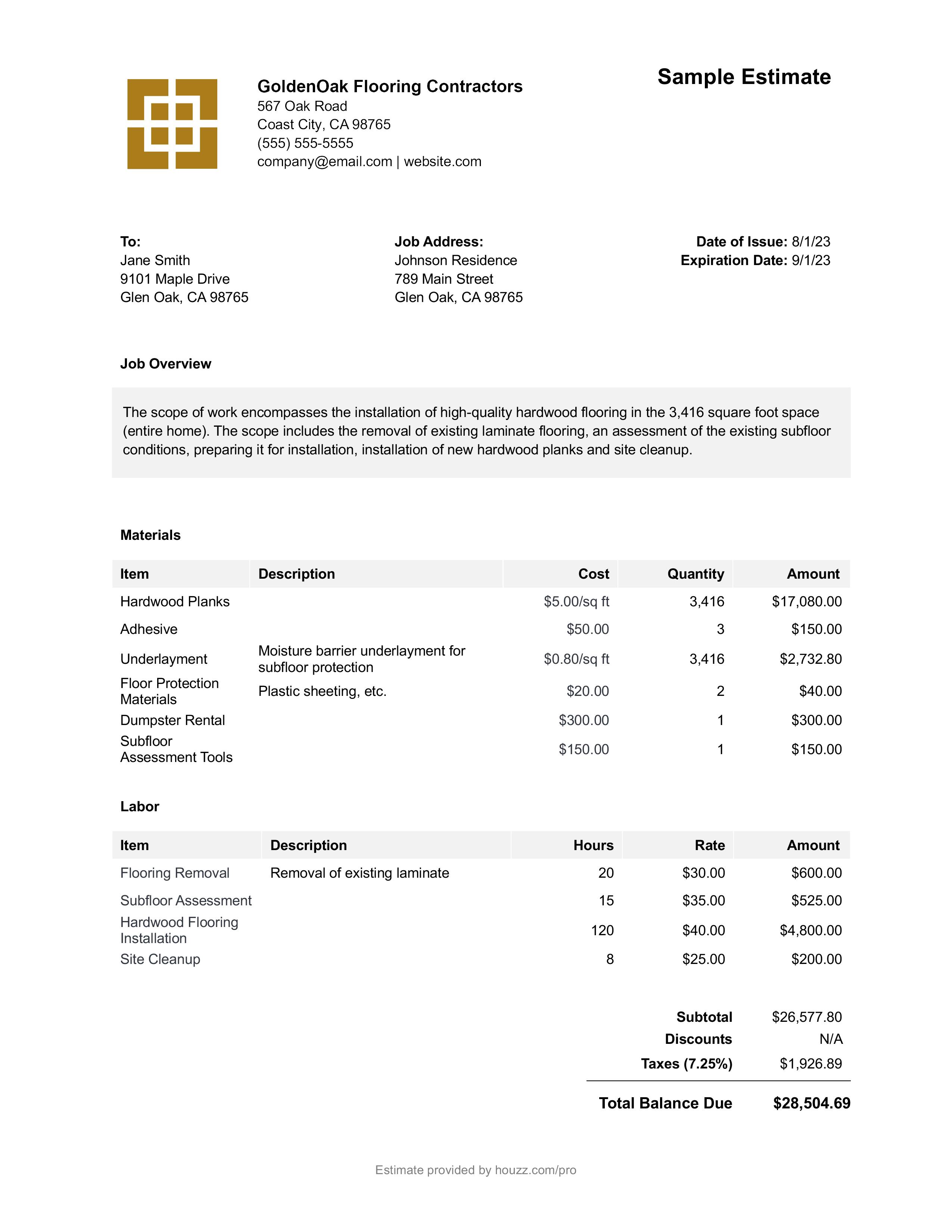Free Template: How to Estimate a Flooring Job
Learn how to estimate a flooring jobs whether it requires hardwood or laminate, or tile

Learning to estimate flooring jobs takes a little practice to get right. But with the right tools and guidance, flooring pros can produce professional, accurate estimates as quickly as clients expect to receive them. In this article, we explain how to estimate flooring jobs, what to include in the estimates and where to find the information you need to fill in the blanks. Also included is a free, downloadable flooring estimate template. The fully editable flooring estimate template is easily customizable to meet the needs of your projects and business.
Click on a link below to jump to the section you’re most interested in:
- Download our free flooring estimate template
- What is a flooring estimate?
- Why are flooring estimates important?
- When do you send a flooring estimate?
- What should be included in a flooring estimate template?
- Optional sections to include in a flooring estimate template
- How to create a flooring estimate step-by-step
- Alternatives to printable flooring estimate templates
- Final tips on how to estimate a flooring job
Download our Free Flooring Estimate Template

Here's a Flooring Estimate Template on Us!
Customize this Flooring Estimate Template to secure your next job.
Launching your own flooring business can be a steep learning curve because there is so much to know. Perfecting your estimation skills is likely near the top of your list when it comes to skills you are seeking to master.
In this article, we provide a free flooring estimate template for Excel and Word to guide you through creating some of your first estimates and include a flooring estimate example for inspiration. The downloadable flooring estimate template makes it easy to print and email your completed estimate when you are done. And, because the flooring estimate template is fully customizable, you can edit it to fit your business and needs.

In the long run, you will likely consider estimating software to join the pros who use it to create flooring cost estimates more quickly and efficiently as part of their business management software. Explore Houzz Pro flooring takeoff and estimate software with a free trial of Houzz Pro.

What is a Flooring Estimate?
A flooring cost estimate of what it will cost to replace or install a new floor helps set expectations for potential clients who want an idea of what the job will cost them. The term is often used interchangeably with quote, bid or proposal, but there are distinct differences among the four. A flooring estimate, for example, is typically not legally binding because it is an educated guess of the cost of materials, labor and other expenses associated with the project.
A quote is a more specific prediction of what the job will actually cost and is binding once all parties agree to it in writing. A bid and proposal each are even more detailed, and may be requested depending on the job and the client.

Why are Flooring Estimates Important?
As a flooring contractor, you need to know how much each project will cost you, and how much you need to charge to clear a profit margin on every job. A flooring estimate helps you figure it out. The total costs are influenced by several factors, and can vary greatly from project to project. Here are some common considerations when estimating how much a flooring project will cost:
- Type of Flooring The cost of a project will vary depending on the type of flooring your client chooses. For example, a hardwood flooring estimate template should include more expensive options, as would tile and stone, and, the prices differ within each category.
- Timeline Be realistic with your customers about how long it will take you to complete a project, and figure in overtime costs for expedited jobs.
- Square Footage The more area there is to cover the more the material and labor costs will be. Therefore, taking accurate measurements are essential to making reliable estimates.
- Moldings Don’t forget to consider the moldings, baseboards and other trim as part of your project estimates.
- Sealants Be clear about whether the floor needs to be sealed, and what type of sealants or finishes will be added to the flooring, and figure in those costs.
- Condition of Subfloor Do you know what is underneath the existing flooring? Account for the possibilities of surprises once the floor is ripped up, and consider repairs that will need to be made.
- Underlayment The subfloor material also adds to the costs of the project so be sure to calculate those costs per square foot, and any extra layering that is requested.
- Disposal of Existing Floor Determine how much it will cost to haul away and dump the existing floor material if that is part of the services you offer. Not every facility accepts construction material so account for transportation and disposal fees too.
- Moving Furniture Everything takes time, including relocating the furniture in a room. Clarify who is responsible for moving the sofas, chairs, tables, lamps and other items that need to be out of the way when the floor is being installed.

When do you send a flooring estimate?
Estimates help set expectations for a client by giving them an idea of how much the flooring project will cost and whether it matches their budget. It is often the first document delivered to a potential customer and precedes a more detailed quote should the client review the estimate and decide to take the next steps. Doing an estimate can be especially useful in gauging whether a client is committed to the project without devoting the time it takes to do a full quote only to learn that the customer has decided not to do the work at this time.
Unlike an estimate, a quote becomes legally binding and serves as the cost basis for the project once it is signed off by all parties. For some jobs, you may be asked to submit a formal bid, along with other flooring contractors. A bid is more detailed and exact than an estimate. The same is true for a proposal, which has the same type of information as a bid and quote, but also includes more extensive details about your company and past projects.

What Should be Included in a Flooring Estimate Template?
- Company Information Brand your estimate with your flooring business details, and logo to make it uniquely yours. Include the name and contact information of the person who will be the main contact person to make it easy for clients to reach out and have their questions answered.
- Client Information Include the name of the client, name of project and the person who will be the main contact point as the flooring work progresses.
- Estimate Number & Date This information helps you keep your estimates organized and makes them easier to find as the volume of your projects increase over time. Create an intuitive numbering system to simplify locating documents.
- Table of Labor & Materials Detail the estimated labor and materials that will be needed to complete the project to make it easy for clients to understand the costs behind the flooring installation. This may include line items for materials such as flooring boards, tiles, grout trim and more.
- Summary of Costs This is a tally of all the costs involved in the flooring project, and any other costs.
- Acceptance & Signature Include a section for all parties to sign, date and accept the floor cost estimate template.

Optional Sections to Include in a Flooring Estimate Template
Besides covering the basics, you may want to add additional sections to your flooring cost estimate template, especially in cases where you think the extra information will increase your chances of winning the job. Here are some optional sections to consider depending on the job:
- Scope of Work This details what work is included in the project and which items are not. It shows the homeowner that you understand the extent of the flooring work they are seeking for their property and can serve as a reference should questions arise later. This provides clarity on the flooring work included in the estimate, and those which would be add-ons to the estimate or omitted.
- Discounts Do you offer reduced rates for first-time customers or clients that pay for the project up front? Include any details here.
- Terms & Conditions This section could cover your policy on change orders or how much time a client has to inspect and sign off on a completed flooring project. Some pros include an expiration date for the floor cost estimate since prices change over time. This can also double as a deadline for clients to make a decision.
- Disclaimer This can clarify that an estimate is not a formal contract for the floor project and will be followed with a more detailed quote.
- Additional Notes Is there anything else that needs to be addressed? This could be a place to note the average cost of removing existing flooring, for example.

How to Create a Flooring Estimate Step-by-Step
1. Choose an Estimate Template or Tool Decide what tools you need to begin. A free floor estimate template can help you to develop your estimating skills. A downloadable floor estimate template serves as a guide of what to include in the estimate. Make sure you pick an editable floor estimate template that you can easily customize to meet the specific needs of the project and your business. Floor estimating software also greatly reduces the time it takes to create accurate and professional-looking estimates, and is another option to consider.
2. Review Project Plans Do you have all the measurements you need as well as a full understanding of the flooring project? Review the plans, and if needed, visit the property and consult with the homeowner to assure that you know the vision and scope of the work they are seeking.
3. Determine the Type of Flooring With so many categories of flooring and variations within each, know exactly what the client is seeking to estimate the costs. Wood flooring, for example, is more expensive than laminate. And, prices can vary greatly among wood flooring depending on the kind of tree and type of flooring. Solid wood flooring is more costly than engineered wood floors which are less expensive, but less durable than solid wood. Educating clients about the pros and cons of different flooring choices can help them make their decisions.
4. Consider Extra Installation Costs A flooring installation estimate template should include removal of the existing floor and the condition of what lies underneath. These steps can bring additional costs when floors are being replaced. In new construction, these costs are not a factor, but the customer may be seeking extra insulation or more layers of under flooring.
5. Confirm the Timeline Be realistic in determining how long the project will take and when you can begin work. If a client is seeking to fast-track the flooring work, figure in the additional costs it would take for your business to meet the schedule.
6. Estimate Material Costs
Knowing the costs of flooring materials and the labor it will take to carry out the project is at the heart of drafting and accurate estimates:
- Volume of Materials Start with an accurate measurement of the total flooring area and multiply it by the cost per square foot of the flooring material. You will also need to determine the cost of other materials such as the baseboard molding. For replacement floors, clarify whether the current baseboards will be replaced or repainted.
- Type of Materials Know exactly what type of flooring the homeowner is seeking whether it is tile, laminate, vinyl, carpeting or wood. Prices vary within every type depending on the quality and type of the flooring choice. For example, tile and stone flooring is a popular choice but there is a wide range of tile types such as clay, ceramic and porcelain as well as varied textures, colors and designs that can impact the price.
- Additional items: Figure in everything else you will need such as sanding belts, nails, screws, filler, stain and more to assure that your flooring estimate includes all of the costs of the project.
7. Estimate Labor Costs The cost of your labor will depend on availability, productivity and the skill level required for a flooring job. Factor in the length of time it will take to complete a project. Consider whether your current team can carry out the job, and add in any costs of recruiting additional workers or specialized workers.
8. Fixed Costs It costs money to run a business so you will need to figure in your overhead expenses. Add up your costs for items such as rent, vehicles, utilities, computers, and more to come up with an annual or monthly figure. You can prorate these costs - let’s say the job will take 30 days, then you can incorporate the monthly estimate of fixed cost into your estimate.
9. Markup Your markup and margin helps assure that you are earning a profit to keep your business growing and making the hard work you do worthwhile. An accountant or trusted advisor can help you work out these formulas to add to the total cost of the job.
10. Calculate Total Costs Add everything up to reach your total estimate
11. Seek a Second Opinion Ask someone you trust to review your estimate to find anything you may have missed.
12. Review & Send Go over your estimate one more time and hit send!
13. Track Feedback & Approvals Create a process to keep on top of feedback and questions from your customers and ultimate approvals.

Alternatives to Printable Flooring Estimate Templates
Using a downloadable flooring estimate template is lightyears ahead of starting with a blank screen or using pen and paper to create your estimate. It serves as a guide to help you learn the skills of estimating.
However, many flooring contractors soon opt for flooring estimating software to create their flooring estimates even more quickly and efficiently. With a flooring takeoff software like Houzz Pro, the takeoff tool is built in and you can use the pricing lists supplied for your region, or upload your own.

Final Tips on How to Estimate a Flooring Job
Before you begin drafting your flooring cost estimate, here are a few parting tips to consider:
- Scope out the Scope Do you completely understand the full extent of the flooring project before you? Make sure you have reviewed the plans, sought clarifications from clients and know all the details of the project from start to finish
- Know the Skills Required Consider how the skills of your team match up with those required for the flooring job, and whether you will need to bring in other workers to lay and cut tile for example. The availability and skill level of workers in your region will impact the rate you will need to pay them.
- Factor in Project Risks Account for possible risks such as discovering structural damage in the subflooring, or overtime costs for fast-tracking a project.
- Don’t Overlook Overhead Valuing the cost of doing business helps assure that you do not come up short in the end, and allows you to grow your company.
- Include Related Services Consider and clarify who is handling related services such as pouring a concrete underflooring, painting or repairing floor boards, disposing of the current flooring, prepping the site, moving furniture, and more.
- Compare with Your Competition Find out how the prices you are charging match up with your competitors in the region to see where you fit in the marketplace.
- Keep Learning Make adjustments along the way as the market changes, and apply what you learn as you do more and more flooring estimates.

Conclusion
In this article, we have attempted to remove some of the mystery of how to do a flooring estimate. With the right tools and knowledge, flooring contractors hone their estimation skills much in the way they learned to do a flooring job: with precision and efficiency.
Explore our takeoffs and estimating features with a free trial of Houzz Pro flooring contractor software.

Want advice delivered to your inbox?
Unlock industry insights and updates for contractors and design pros
By signing up, I agree to the Houzz Terms of Use and Privacy Policy and that Houzz may use my information to contact me about relevant content, products, and services.






Join the conversation by commenting or asking a question below. The Houzz team reads every single comment, and we’ll get back to you by email if you need us!